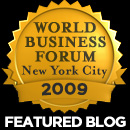Apr15
Andrea Meyer
Point: Define priority innovation areas to harness employee energy
Story: When it comes to innovation, Harrah’s Entertainment doesn’t play games. The operator of a global chain of 50 casinos is pursuing a theme-focused innovation strategy similar to technology giant Hewlett-Packard and venture capital firm The Foundry Group. The company identified six areas of interest (akin to HP’s 8 themes and Foundry’s 5 themes – see Innovation Investment Strategy). Harrah’s target areas are: enabling technologies (such as wireless and radio frequency identification); enabling platforms (cloud computing, service-oriented architecture, anything-as-a-service); “smart” service (self-service kiosks); interactive CRM; next-generation gaming; and expanded channels to reach customers.
An innovation team of about 10 people from IT, marketing, customer service and gaming evaluate idea submissions from employees. Harrah’s also taps the innovations of vendors and is considering enlisting the public in seeking new innovations in gaming and entertainment. To gather even more feedback, Harrah’s created an “Innovation Portal” where employees can vote for their favorite innovation. Top management (CEO Gary Loveman and VP of Innovation Chris Chang) then decides which ideas ultimately get funded.
Action:
- Identify the areas of top priority to your firm, to help steer energy & momentum in the areas that will provide most value to your firm.
- Use themes to look for the deeper, long-term enablers and platforms rather than shallow short-term gadgets and projects.
- Ask employees for suggestions, feedback or votes on ideas within these areas
- Consider involving vendors, customers and the public as well, to expand the pool of ideas. (This strategy will require thinking through the IP issues.)
For more information on Harrah’s: Network Computing article
Case study, Customers, How-to, Innovation, New Product Development, Strategy
Apr13
Andrea Meyer
Point: How you get a product to market may be as important as what you get to market.
Story: The previous post looked at product systems innovation to build a new car. Going a step further: some companies expand the systems thinking to include distribution and service. Consider Tata Motors, which created the world’s cheapest car, the Tata Nano. To reach a retail price of $2,000, Tata focused on the costs of every system of car, including the system for distributing and selling the car. To keep costs low, Tata created a modular design and an innovative distribution model. Tata will manufacture modules centrally and, in some cases, ship the cars as kits to local entrepreneurs who will assemble & sell them. Tata designed to the modules to be glued together rather than welded because gluing is less expensive and doesn’t require costly welding equipment. Tata will also train the entrepreneurs to do servicing.
Similarly, Hindustan Unilever pioneered a distribution model in 2001 to get its personal care products into the hands of rural villagers. A significant fraction of rural villages lack paved roads, making traditional truck-based distribution very difficult. The company developed a network of 14,000 women and women-owned co-ops to serve 50,000 villages. The women handle the logistics and door-to-door retailing of a range of personal care products. To address the needs of the market and the novel distribution system, Hindustan Unilever changed product packaging. By using this approach, Hindustan Unilever does not have to deal with the problem of moving product in rural India. The women or their employees come to the company’s urban distribution centers to get the product.
Action:
* When designing new products or services, consider how those products will be distributed.
* Think about the role that local entrepreneurs or business partners can serve
* Design the product to support the distribution channel (e.g., modularity, ease of assembly, packaging, etc.)
For more information: Vijay Govindarajan discussed Tata Motors’ strategy at the HSM webinar on March 18 and will be speaking at the World Innovation Forum being held May 5-6, 2009 in New York City
Hindustan Unilever’s distribution model: Discussed at MIT Center for Transportation and Logistics Roundtable on Supply Chain Strategies in Emerging Markets led by Dr. Edgar Blanco.
Case study, Entrepreneurs, Growth, How-to, Innovation, New Product Development, Opportunity, Strategy
Apr04
Andrea Meyer
Point: Working with a partner in a different industry can yield innovative results
Story: Gabriel is a Danish manufacturer of environmentally-friendly upholstery fabrics. Founded in 1851, it’s one of Europe’s leading suppliers of furniture textiles and was voted the most innovative company in Denmark in 2007. Because Gabriel knows that it can’t create every idea in-house, the company uses open innovation to weave in the capabilities of outside partners. Open innovation means intentionally leveraging the research and technologies of outsiders, rather than only relying on internally-generated innovations. Gabriel is constantly looking for new materials, new production technologies, and new applications for furniture textiles.
In particular, Gabriel gives special attention to how it forms partnerships for open innovation. First, Gabriel ensures that its partners have the right competencies to match the innovation activity at hand. Second, partners sign a confidentiality agreement so that the ideas can be exchanged freely. Open innovation is even possible with competitors, provided that the companies create clear and explicit contractual agreements from the outset.
In one example, Gabriel looked at the manufacturing technologies used by the car industry to make car seats. After all, a car seat is like a chair on wheels. Together with furniture company Hay, Gabriel introduced a fabric electro-welding technology originally used by Fiat to make car seats. The method laminates tough exterior fabric covering and soft interior filler in a way that greatly reduces production costs of furniture.
Action:
- Look outside your company and outside your industry for people that have similar problems (and possibly useful solutions)
- Identify innovative products or methodologies for collaborative and adaptive projects.
- Create a partnership with the outside co-innovator to share ideas, results, or profits as appropriate.
For more information: Gabriel A/S
Case study, How-to, Innovation, New Product Development, Strategy










